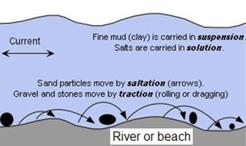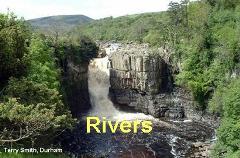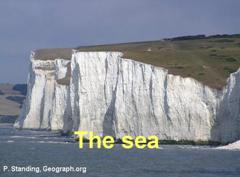By Water
Around the world, moving water picks up and transports millions of tonnes of sediment every day, along rivers, coasts, and even in the deep oceans.
 Sediment, whether picked up by flowing water or by waves, is moved along in one of four ways:
Sediment, whether picked up by flowing water or by waves, is moved along in one of four ways: - Traction is the rolling or dragging of large grains along a river bed or shore, aided by the push of the smaller grains (below).
- Saltation is the bouncing of sand grains as they are picked up, carried along, and dropped repeatedly by flowing water.
- Fine particles (silt and clay) are carried in Suspension in the water – they will only settle out if the water is still.
- Soluble salts are carried in Solution in the water – the sea is obviously salty, but rivers contain dissolved salts, too.
Erosion & Transport by Rivers
 More on Erosion and Transport by Rivers.
More on Erosion and Transport by Rivers. Sediment transport by water animation
Erosion & Transport in the Sea
 More on Erosion & Transport in the Sea.
More on Erosion & Transport in the Sea. 
